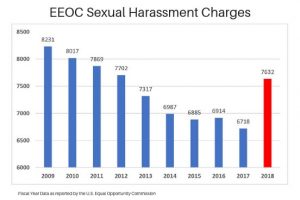On October 31, 2018, the U.S. Equal Employment Opportunity Commission reported final data on fiscal-year 2018 sexual harassment charges. The EEOC had issued preliminary numbers for its fiscal year ending September 30, 2018, earlier in October. The new figures show an even greater uptick in sexual harassment cases.
[Click for more on the EEOC’s preliminary 2018 sexual harassment data report.]
Final FY 2018 Sexual Harassment Statistics
The EEOC is now reporting a 13.6% increase in sexual harassment charges versus FY 2017. Based on prior-year data, this equates to approximately 7,632 sexual harassment cases filed between October 2017 and September 2018.
Initially, the EEOC reported a 12% rise in these charges.
Any meaningful increase in sexual harassment charges is notable. As shown in the chart below, there had been a consistent decline in such cases over the past decade.
Ironically, the EEOC’s 2018 fiscal year began right at the beginning of the #MeToo movement. Although the statistics do not necessarily prove causation, the circumstances strongly imply a connection.
The EEOC also disclosed that hits on its sexual harassment webpage doubled over the past year.
EEOC Calls for “Holistic Approach” to Prevent Harassment
The EEOC released the updated statistics at a public meeting entitled “Revamping Workplace Culture to Prevent Harassment.” The meeting was held at the agency’s headquarters in Washington, D.C.
“Leadership and accountability set the tone and the expectation that harassment will not be tolerated in a workplace,” said Victoria A. Lipnic, Acting Chair. “Over the past year, we have seen far too many examples of significant gaps in both areas. Our witnesses today stressed how both leadership and accountability must also be driven throughout an organization from the line employees, to the supervisors, to the CEO, and to the Board.”
EEOC Commissioner Chai R. Feldblum co-chairs the agency’s Select Task Force on the Study of Harassment in the Workplace. She added that “No one element, alone, will suffice. Instead, it takes a holistic effort that must start at the top with strong and committed leadership.”
Several witnesses representing various constituencies presented at the October 31, 2018 public meeting. These included Alejandra Valles, Secretary-Treasurer of SEIU United Service Workers West; Anne Wallestad, president and CEO of BoardSource; and Professor Christine Porath of Georgetown University.
The EEOC will also accept public comments into the record of the meeting for 15 days.
Additional information about the public meeting is available here.
An Issue We Can’t Ignore
The latest reports from the EEOC only underscore what has already become evident. Our workplaces are not yet free from sexual harassment and employees are coming forward more often.
Employers must acknowledge at least their legal obligation to prevent and redress incidents of sexual harassment. Failing to do so can have a devastating impact on your company.
For more updates on related topics of interest and to receive notice of our free informational webinars, click here to sign up for the Horton Law email newsletter.




You must be logged in to post a comment.